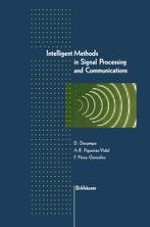1997 | OriginalPaper | Buchkapitel
Biometric Identification for Access Control
verfasst von : Shang-Hung Lin, S. Y. Kung
Erschienen in: Intelligent Methods in Signal Processing and Communications
Verlag: Birkhäuser Boston
Enthalten in: Professional Book Archive
Aktivieren Sie unsere intelligente Suche, um passende Fachinhalte oder Patente zu finden.
Wählen Sie Textabschnitte aus um mit Künstlicher Intelligenz passenden Patente zu finden. powered by
Markieren Sie Textabschnitte, um KI-gestützt weitere passende Inhalte zu finden. powered by
Recently, with technological advance on microelectronic and vision system, true verification of individual identities has now become possible. This technology is based on a field called biometrics. Biometric systems are automated methods of verifying or recognizing the identity of a living person on the basis of some physiological characteristic, like a fingerprint or face pattern, or some aspect of behavior, like handwriting or keystroke patterns. The objectives of this chapter are to investigate various biometric identification methods and to develop useful techniques for implementing good biometric identification systems. In particular, we focus on two types of biometric methods, namely, face recognition and palm print recognition. Among all the biometric identification methods, face recognition has attracted much attention in recent years because it has potential to be most non-intrusive and user-friendly. In this chapter we propose an integrated face recognition system based on probabilistic decision-based neural networks (PDBNN)[33]. The face recognition system consists of three modules: First, a face detector finds the location of a human face in an image. Then an eye localizer determines the positions of both eyes in order to genef.ate meaningful feature vectors. The facial region proposed contains eyebrows, eyes, and nose, but excluding mouth. (Eye-glasses will be allowed.) Lastly, the third module is a face recognizer. The PDBNN can be effectively applied to all the three modules. It adopts a hierarchical network structure with nonlinear basis functions and a competitive credit-assignment scheme. This chapter demonstrates a successful application of PDBNN to face recognition on the public ORL face database. Regarding the performance, experiments on three different databases all demonstrated high recognition accuracies as well as low false rejection and false acceptance rates. As to the processing speed, the whole recognition process (including PDBNN processing for eye localization, feature extraction, and classification) consumes approximately one second on a Sparcl0, without using a hardware accelerator or co-processor. A new biometric identification scheme using human palm print information is proposed. This scheme extracts discriminant features from a grayscale palm image by edge filtering and Hough transform, and recognizes the input pattern by a novel structural matching algorithm.face recognition system demonstrated the power of the PDBNN pattern classifier, and the palm print recognition system indicates the importance of a good feature extractor. Due to their non-intrusiveness, both systems are very suitable for gateway access control and computer security management.
